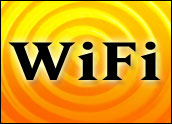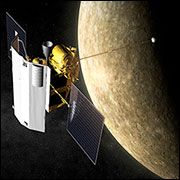
Ten-4. Back to you. Over.
On a radio or over the TV airwaves, speakers have to rely on back-and-forth communications because radio traffic only flows in one direction at a time on a frequency. Or so said scientific conventional wisdom, until Stanford researchers developed so-called “full duplex” radios that can send and receive signals at the same time. Twice as fast as existing radio devices, the new technology promises less congested, more efficient networks.
“Textbooks say you can’t do it,” said the technology’s principal investigator Philip Levis, assistant professor of computer science and of electrical engineering at Stanford. “The new system completely reworks our assumptions about how wireless networks can be designed.”
Dreams of supercharged WiFi connections are already dancing.
“Full-duplex technology like this could literally double the speed of WiFi connections almost overnight,” said Jason Katz, founder and CEO of instant messaging and wireless video technology provider Paltalk.com. “This could greatly enhance each and every WiFi user’s Internet experience.”
WiFi Workaround
Used to telephones and cellular phones, most people don’t think about the inability to communicate simultaneously on radio. Perhaps they should, because cellphones route around the problem with expensive technologies whose costs get passed along to consumers — and make similar fixes unfeasible for wireless networks that often come free, including WiFi.
The idea for communications simultaneity came virtually simultaneously among three Stanford electrical engineering graduate students — Jung Il Choi, Mayank Jain and Kannan Srinivasan.
They wanted to answer this question: “What if radios could do the same thing our brains do when we listen and talk simultaneously: screen out the sound of our own voice?” Stanford science writer Sandeep Ravindran explained.
Simultaneous talk on a radio can build a Tower of Babel in no time.
“If both people are shouting at the same time, neither of them will hear the other,” Levis told TechNewsWorld.
With help from Levis and Sachin Katti, an assistant professor of computer science and of electrical engineering, the grad students had to overcome an intrinsic flaw in radio communications. That is, a radio’s own transmissions — billions of times stronger than anything it might pick up from another radio — overwhelm incoming signals, Levis explained.
“It’s like trying to hear a whisper while you are shouting,” he said. Filtering out the noise became the basis for the new solution, which Paltalk’s Katz said should encourage further innovations.
“I would think enabling this technology would encourage more WiFi projects designed to blanket large areas such as cities,” he told TechNewsWorld. “Networks should be far less congested, and cities would greatly benefit.”
Double Time
Sending and receiving signals simultaneously doubles the amount of information sent, Levis said, which means faster home or office networks — and a boost to air traffic controllers, a high pressure bunch often beleaguered by the demands of skyward communication critical to safety.
Presently, if two aircraft try to call the control tower at the same time on the same frequency, neither will get through. Such blocked transmissions have caused aircraft collisions, Levis said, a problem the new approach would resolve.
Provisional patent in hand, the Stanford group is trying to increase both transmission strength and distance, necessary before the technology is WiFi-ready.
With an instant messaging client that allows users to share video, audio and text with up to 10 people at any time for free, the thought of faster, cheaper networks that allow more people to communicate at once impresses Paltalk’s Katz.
However, where the Stanford innovation goes from here depends “largely on how the inventors decide to commercialize it,” he explained. “Regardless, it should cause a new cycle of hardware purchasing to enable the technology.”






















































When cellphones went from analog to digital, massive sound quality was lost as well as features. One of the features of the older analog cellphones was Full Duplex. They were exactly like talking on a landline. I was very involved in the technology and marketing of digital cell phones and cellular carriers literally lowered the quality more and more and more, to their surprise, consumers didn’t complain! So today, that’s why your cellphone communications sound like crap. It’s sad. The companies didn’t have to be so greedy. Originally, they were regulated by the government and were forced to maintain a certain level of quality, just like landlines were, but the Republicans wiped out all the regulations "the free market will keep the quality high" yeah, right! The whole point of government regulations are exactly this, to protect the naive population from the sophisticated tricks of the effing corporations!
Full Duplex is indeed nothing new. Lots of confusion could have been prevented had the author made it clear that this is Full Duplex over a SINGLE frequency, not a pair of frequencies. There are other technical errors but I suspect the author doesn’t have much background in radio. Other work has been done on full duplex over a single frequency but lots of issues prevented it from being of practical use.
THATS STRANGE,I HAVE BEEN USING FULL AND HALF DUPLEX FOR THE LAST 25 YEARS ON 2 METERS & 70 CM
BAND.the Stanford professors better wake up.HAM RADIO OPERATORS DID THE DESIGN WORK ON FULL DUPLEX ABOUT 30 YRS AGO. IM TALKING VOICE & DATA.
BOBFEINSTE
Interesting idea. The approach of using dual transmit antennas to create a point of cancellation between the antennas would seem to be very frequency dependent and local environment dependent. The transmit signal might bounce off a nearby object, return at a different phase and interfere with the received signal. Would also seem that if the phase of the transmit signal is dynamically adjusted to account for local environment bounce, the result would be beam steering. If there is a cancellation point between the transmit antennas, one would expect some attenuation along a line perpendicular to the transmit antennas extending in both directions. Wonder how they are compensating for those problems.